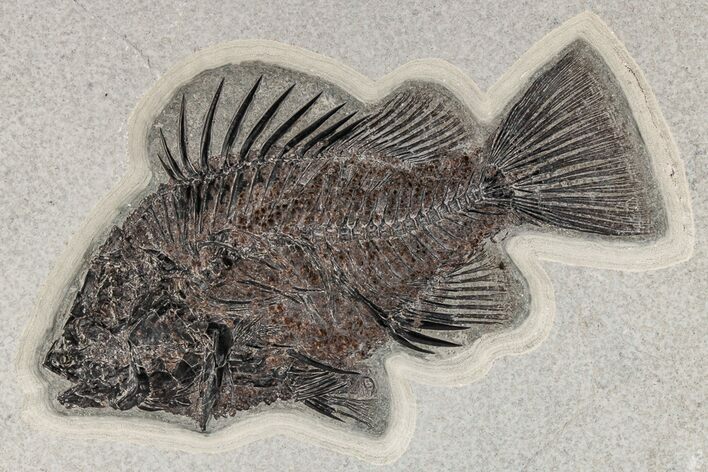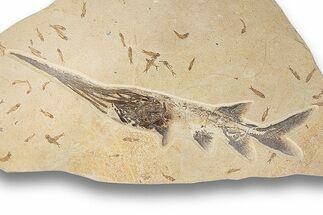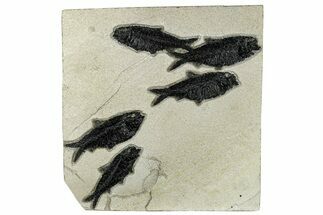This Specimen has been sold.
10.2" Fossil Fish (Priscacara) - Top Quality Specimen!
This is a phenomenally preserved, 10.2" long Priscacara serrata fish from the Green River Formation. It was collected from the Lindgren quarry near Kemmerer, Wyoming. It is nicely centered on a rectangularly cut slab of shale. The level of detail that preserved on this specimen is exquisite. From the scales to the teeth and individual vertebra, this fish stands apart.
This specimen includes a display stand.
This specimen includes a display stand.
Priscacara is an extinct genus of temperate bass that lived during the Eocene. It is an uncommon species in the Green River Formation, representing less than 1 percent of total fish fossils. It is a favorite among fossil collectors, particularly those specimens with all of their dorsal spines pointing upwards. It can occasionally reach impressive sizes in excess of 16 inches in length. Priscacara has a large mouth and impressive array of teeth can often be seen in detail on larger, well-preserved specimens.
Priscacara is more frequently found in shoreline lake deposits and less frequently found in rocks deposited in the center of the lake. Its appearance is very similar to that of Cockerellites, a genus of smaller schooling fish found in large numbers in the mid-lake quarries. Cockerellites maxed out in the 5 to 6-inch range, so specimens larger than that are assumed to be Priscacara. Cockerellites have more dorsal and anal fin rays than Priscacara and a significantly smaller mouth.
Priscacara is more frequently found in shoreline lake deposits and less frequently found in rocks deposited in the center of the lake. Its appearance is very similar to that of Cockerellites, a genus of smaller schooling fish found in large numbers in the mid-lake quarries. Cockerellites maxed out in the 5 to 6-inch range, so specimens larger than that are assumed to be Priscacara. Cockerellites have more dorsal and anal fin rays than Priscacara and a significantly smaller mouth.
About Fossil Lake
50 million years ago, in the Eocene epoch, these fish thrived in Fossil Lake, which was fed by the Uinta and Rocky Mountain highlands. The anoxic conditions at the bottom of Fossil Lake slowed bacterial decomposition, prevented scavengers from disturbing corpses, and, most interestingly, suffocated creatures that ventured into the oxygen-starved aquatic layer. The result is a miraculous exhibition of Eocene biota: a subtropical aquatic community within sycamore forests, teeming with creatures such as freshwater stingrays, dog-sized horses, menacing alligators, early flying bats, and one of the first primates.
50 million years ago, in the Eocene epoch, these fish thrived in Fossil Lake, which was fed by the Uinta and Rocky Mountain highlands. The anoxic conditions at the bottom of Fossil Lake slowed bacterial decomposition, prevented scavengers from disturbing corpses, and, most interestingly, suffocated creatures that ventured into the oxygen-starved aquatic layer. The result is a miraculous exhibition of Eocene biota: a subtropical aquatic community within sycamore forests, teeming with creatures such as freshwater stingrays, dog-sized horses, menacing alligators, early flying bats, and one of the first primates.
SPECIES
Priscacara serrata
LOCATION
Lindgren Quarry, Kemmerer, Wyoming
FORMATION
Green River Formation
SIZE
10.2" long on 16.3 x 12" rock
CATEGORY
SUB CATEGORY
ITEM
#206441
We guarantee the authenticity of all of our specimens.
 Reviews
Reviews














